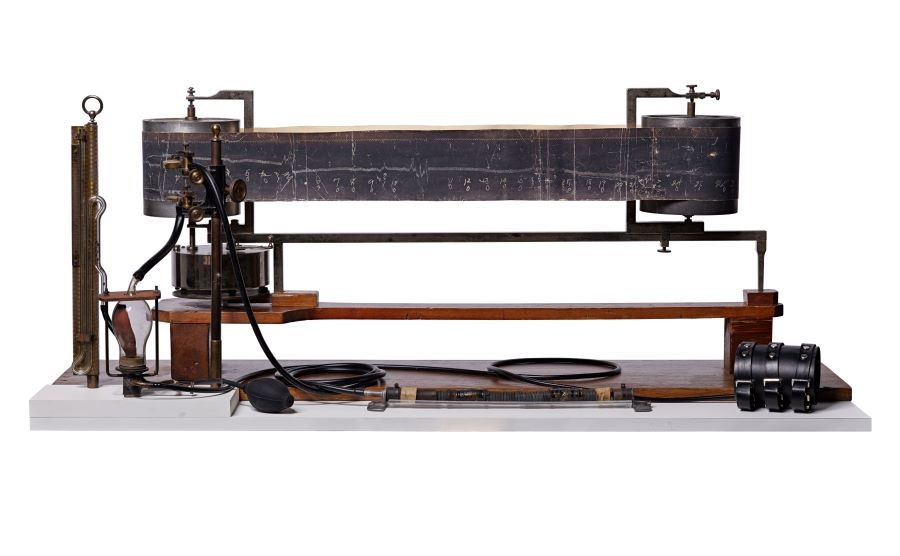Smithsonian’s “Forensic Science on Trial” Exhibition Explores What Happens When Science Enters the Courtroom

Polygraph (cardio-pneumo-psychograph); 1921. Gift of City of Berkeley Police Department. Photo by Jaclyn Nash, National Museum of American History.
The Smithsonian’s National Museum of American History will open “Forensic Science on Trial” June 28, a new exhibition that explores the way people influence the development, presentation and interpretation of forensic science. The one-year exhibition will run through June 2025 in the museum’s 1,000-square-foot Albert H. Small Documents Gallery.
Objects and archival documents on view will span 150 years of historic cases and include about a dozen different forensic techniques, from hair to handwriting analysis. Among the objects on view will be arsenic tests from the 1872 trial of Lydia Sherman, who was suspected of poisoning three of her husbands and eight children; one of the earliest polygraphs used for lie detection created by John A. Larson in 1921; an early sexual-assault examination kit co-developed by Martha Goddard and Louis Vitullo; and materials related to fingerprinting and DNA identification on loan from the FBI. In addition to the courtroom, the exhibition will look at how the media, through news coverage and on fictional television shows, such as Showtime’s Dexter, shape how the public understands forensic evidence and what is called the CSI: Crime Scene Investigation effect.
“The nation’s popular culture, from streaming series to podcasts, reflects the current fascination with true crime and forensic evidence,” said Anthea M. Hartig, the museum’s Elizabeth MacMillan director. “‘Forensic Science on Trial’ mines the museum’s extensive science collections as well as special loans to provide our audiences with a fascinating look at how forensic science has long been a part of the pursuit of justice.”
Divided into three sections, “Of People,” “By People” and “For People,” the exhibition underscores the long-standing desire to create systems that can reliably turn trace evidence of criminals into convictions, how the collection and judgement of data can be influenced by personal beliefs and the way the past can shape how data is exhibited for those tasked with deciding guilt or innocence.
The exhibition presents objects in pairings under common themes such as privacy, regulation, uncertainty and acceptance. One pairing juxtaposes an object from the early years of bitemark analysis—namely a photograph of a wax bite impression of Ted Bundy’s teeth used in his 1979 murder trial—with a bite apparatus used by researchers at the University at Buffalo School of Dental Medicine between 2009–13, whose results raised questions about some of the fundamental tenets of this practice.
Loans from individuals as well as the Massachusetts and New Jersey State Police Departments allow for the presentation of materials from multiple “trials of the century.” These include a bullet and pistol from the 1921 trial of Italian immigrants and anarchists Nicola Sacco and Bartolomeo Vanzetti for killing two people during a robbery, a handwriting analysis display from the 1935 trial of Bruno Richard Hauptmann, charged with the kidnapping and murder of the son of aviators Anne and Charles Lindbergh and a copy of DNA autoradiographs from the 1994–95 trial of O.J. Simpson. Among the lenders to the exhibition are DNA expert Dr. Robin Cotton, the Innocence Project, forensic dentist Dr. Richard Souviron, the FBI, the Harvard Law Library and Smithsonian Libraries and Archives.
“This history exhibition focuses on forensic science as a human pursuit, created so that visitors, be they scientists, crime show fans, legal experts or potential jurors, can see themselves as people who shape this work,” said Kristen Frederick-Frost, exhibition curator.
“Forensic Science on Trial” is made possible by Andrew and Anya Shiva.
As this exhibition will display objects and present cases related to forensic investigations of murder, sexual assault and kidnapping, it may not be appropriate for younger audiences.
Through incomparable collections, rigorous research and dynamic public outreach, the National Museum of American History seeks to empower people to create a more just and compassionate future by examining, preserving and sharing the complexity of our past. The museum, located on Constitution Avenue N.W., between 12th and 14th streets, is open daily except Dec. 25, between 10 a.m. and 5:30 p.m. Admission is free. The doors of the museum are always open online and the virtual museum continues to expand its offerings, including online exhibitions, PK–12 educational materials and programs. The public can follow the museum on social media on Instagram and Facebook. For more information, go to https://americanhistory.si.edu. For Smithsonian information, the public may call (202) 633-1000.
# # #
SI-196-2024
